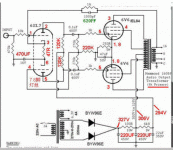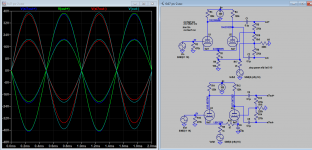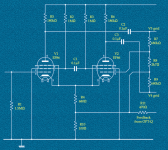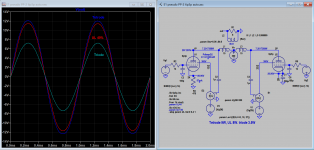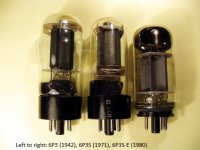I linked one and a picture of it right under Artosalo's post.
6k6 load isn't suitable for cathode bias. It will work but you'll probably have about 10% THD and <15W...
6k6 load isn't suitable for cathode bias. It will work but you'll probably have about 10% THD and <15W...
TheGimp,
Regarding your comment about the Negative Feedback circuitry passing DC current into the output transformer secondary . . .
How bad can it be?
When is 2mA equivalent to 98.5uA?
Example:
A 6,600 Ohm plate to plate to 16 Ohm transformer.
Impedance ratio is 412.5:1
Root (412.5) = 20.3:1 turns ratio
Pass 2 mA DC through that 16 Ohm tap.
1/20.3 = 0.049
0.049 is the equivalent factor of the magnetizing effect of un-balanced DC on the primary, versus DC current on the secondary.
How much equivalent un-balanced primary DC current?
0.049 x 0.002A = 98.5 uA.
The effect of 2mA DC in the 16 Ohm primary is the same as 98.5uA DC across the 6,600 Ohm secondary.
Therefore . . .
As long as the 2 output tubes quiescent DC current matches each other to within 98.5mA;
then and only then will I worry about 2mA DC into the 16 Ohm secondary.
Note:
The cathode and plate currents of a triode are equal, if there is no grid current.
The quiescent cathode and plate currents of both a Pentode and a Beam Power tube are not equal (even if there is no g1 current).
Sensing cathode current, and than setting cathode currents to be exactly equal, does not guarantee that the plate currents will be equal (for either pentode or beam power tubes).
You have to test if the match of the screen currents are equal, if you only match the cathode currents, that results in any un-matched amount of screen currents causing an equal amount of un-matched plate currents.
Your Un-balanced DC May Vary
Regarding your comment about the Negative Feedback circuitry passing DC current into the output transformer secondary . . .
How bad can it be?
When is 2mA equivalent to 98.5uA?
Example:
A 6,600 Ohm plate to plate to 16 Ohm transformer.
Impedance ratio is 412.5:1
Root (412.5) = 20.3:1 turns ratio
Pass 2 mA DC through that 16 Ohm tap.
1/20.3 = 0.049
0.049 is the equivalent factor of the magnetizing effect of un-balanced DC on the primary, versus DC current on the secondary.
How much equivalent un-balanced primary DC current?
0.049 x 0.002A = 98.5 uA.
The effect of 2mA DC in the 16 Ohm primary is the same as 98.5uA DC across the 6,600 Ohm secondary.
Therefore . . .
As long as the 2 output tubes quiescent DC current matches each other to within 98.5mA;
then and only then will I worry about 2mA DC into the 16 Ohm secondary.
Note:
The cathode and plate currents of a triode are equal, if there is no grid current.
The quiescent cathode and plate currents of both a Pentode and a Beam Power tube are not equal (even if there is no g1 current).
Sensing cathode current, and than setting cathode currents to be exactly equal, does not guarantee that the plate currents will be equal (for either pentode or beam power tubes).
You have to test if the match of the screen currents are equal, if you only match the cathode currents, that results in any un-matched amount of screen currents causing an equal amount of un-matched plate currents.
Your Un-balanced DC May Vary
Last edited:
Calculate a push pull circuit that has fixed adjustable bias, and RC coupling to the output tubes.
Calculate the bias voltage, Vbias.
Calculate the output power, up to, but not at the point of grid current on the output tubes.
Now, change the circuit to self bias, and raise the B+ voltage by an amount equal to the fixed adjustable bias voltage of the above circuit (Vbias).
Be sure to use very large capacitance bypass capacitors across the self bias resistors.
Calculate the output power for a 200msec sine wave burst.
Hmm, same output power.
Much typical music (if there is such a thing), will have the same output power, at the same distortion level.
Good.
But of course, a 32 foot organ pipe that puts out 32Hz for 60 seconds will cause the self bias bypass capacitors to charge up, and the cathode to grid bias voltage will shift, and the cathode to plate voltage will shift, and the cathode to screen voltage will shift.
Not good.
Consider the types of music, dynamics, length of sustained tones, etc. that you listen to.
And then decide about bias methods, according to one of the important differences between fixed adjustable bias, and self bias.
All music playback equipment, and music recordings too, needs to be considered as part of a system, and not just as separate components that only have an existence of their own, with no regard for the rest of the system.
Calculate the bias voltage, Vbias.
Calculate the output power, up to, but not at the point of grid current on the output tubes.
Now, change the circuit to self bias, and raise the B+ voltage by an amount equal to the fixed adjustable bias voltage of the above circuit (Vbias).
Be sure to use very large capacitance bypass capacitors across the self bias resistors.
Calculate the output power for a 200msec sine wave burst.
Hmm, same output power.
Much typical music (if there is such a thing), will have the same output power, at the same distortion level.
Good.
But of course, a 32 foot organ pipe that puts out 32Hz for 60 seconds will cause the self bias bypass capacitors to charge up, and the cathode to grid bias voltage will shift, and the cathode to plate voltage will shift, and the cathode to screen voltage will shift.
Not good.
Consider the types of music, dynamics, length of sustained tones, etc. that you listen to.
And then decide about bias methods, according to one of the important differences between fixed adjustable bias, and self bias.
All music playback equipment, and music recordings too, needs to be considered as part of a system, and not just as separate components that only have an existence of their own, with no regard for the rest of the system.
Last edited:
6p3s in triode configuration souds warm but can exceded 10-12w, as a tedrode sound quality is mediocre but swe can reach an output power of 25w, my opinion is that UL configuration is best suited for this tube and i do not think it is a compromise but only an optimal use
Try Quad II driver as para-feed splitter, less distortion and safer as no high voltage is connected to the output.
Attachments
Last edited:
... 6k6 load isn't suitable for cathode bias. It will work but you'll probably have about 10% THD and <15W...
I ravaged an Ampeg VT-40. 6.6k OT, new PT for 400V B+, 250Ω common cathode resistor, 2k common screen resistor, no NFB. I didn't measure THD but I've done a lot of that in the past. 19W was about dead-clean (<2%) and maybe 5% @ 24W out (lightly clipped). About the same with EL34, 6L6GC, 6550 in pairs, or with one 7027 plus one 6L6(metal). I was actually aiming for a medium power amp to live "forever" rather than a TOO DANG LOUD 60W amp that blew up with a stink. I saw no incipient problems, stable as a rock. Did not come back in the 5 years until I left that job.
That's cool...
400V exceeds the plate voltage of a 6L6 (no bloody A, B, C, or G 😀) and the 6P3S. Do I run them at 400V, Of course! Just saying... I missed which tubes it used. If it was a modern 6L6, it was 30W Pd, and not 19W like the 6P3S that means the amp was way more robust from a tube life perspective...
Also, the 6P3S will start to redplate at around 24W in my tests, so it's best to keep it <=20W Pd for any expectancy of long life.
400V exceeds the plate voltage of a 6L6 (no bloody A, B, C, or G 😀) and the 6P3S. Do I run them at 400V, Of course! Just saying... I missed which tubes it used. If it was a modern 6L6, it was 30W Pd, and not 19W like the 6P3S that means the amp was way more robust from a tube life perspective...
Also, the 6P3S will start to redplate at around 24W in my tests, so it's best to keep it <=20W Pd for any expectancy of long life.
6p3s-e can be run well with +ub=450 V. I have done alot with UL. But no experience with ordinary 6p3s.
G2 dissipation is only < 3W for any 6L6 type tube. In my 6p3p (Chinese), anode 420V but screen is only 320V for all modes.
I quote from another forum:
 Message from sem238
Message from sem238 
How much does the anode usually withstand 6p3s
Yes, some managed to poke 600V, naturally a screen with a maximum of 300V and a resistor in the screen grid, but the author of this unit had a box of lamps in reserve.
400V and 50mA is quite normal. With an anode over 250V, the screen grid must be powered from a separate source and monitored for the current, otherwise, at the anode minimums, it itself works as an anode and may burn out.
I quote from another forum:

How much does the anode usually withstand 6p3s
Yes, some managed to poke 600V, naturally a screen with a maximum of 300V and a resistor in the screen grid, but the author of this unit had a box of lamps in reserve.
400V and 50mA is quite normal. With an anode over 250V, the screen grid must be powered from a separate source and monitored for the current, otherwise, at the anode minimums, it itself works as an anode and may burn out.
Yes all true.
But I think IIRC the 6P3S-e has a less capable screen than the plain jane 6P3S.
In particular, again if I recall correctly, the former has lower inter electrode capacitance than the latter, which is why some find it more attractive.
You may be able to tell that I *avoided* the "-e" version once I read both datasheets, and weighed the costs, with the perceived rep of variant "-e".
But I think IIRC the 6P3S-e has a less capable screen than the plain jane 6P3S.
In particular, again if I recall correctly, the former has lower inter electrode capacitance than the latter, which is why some find it more attractive.
You may be able to tell that I *avoided* the "-e" version once I read both datasheets, and weighed the costs, with the perceived rep of variant "-e".
Last edited:
They are 95% the same but one is half the cost... I no longer use "audio" tube for audio save for 6SN7. Better results in my designs can be obtained with cheaper "unwanted" tubes...
- Home
- Amplifiers
- Tubes / Valves
- 6P3S Push Pull Load
